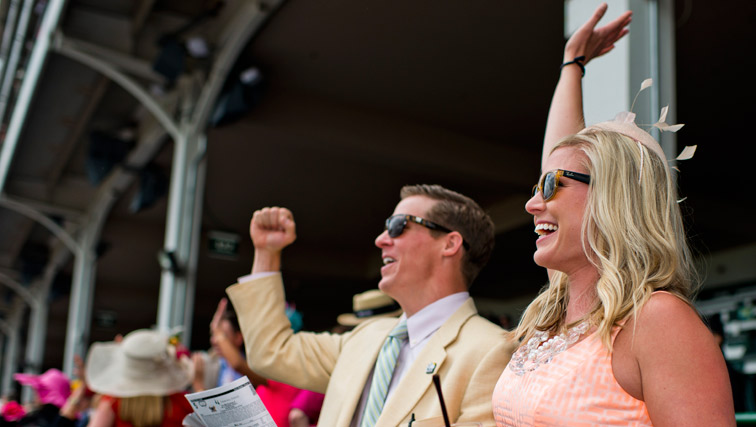Derby Proves Racing Still Alive and Well

Photos by Eclipse Sportswire.
It has often been said in all-knowing tone by some experts that horse racing is a dying sport. Its fan base, they claim, mirrors AARP and its primary sponsors should be funeral homes.
Really?
Try telling the 164,906 fans who turned out at the Kentucky Derby on Saturday that they spent the day at a burial.
And while you’re at, let the 113,071 who attended the Kentucky Oaks on a Friday afternoon know that Halloween is in October and shame on them for masquerading as so many young, vibrant people.
At a time in which the sport’s best 3-year-old colt and filly were both dazzling in victory against a large collection of talented rivals and a two-time Horse of the Year registered his most dramatic victory, Churchill Downs enjoyed a fabulous weekend. The attendance for the Derby was the second highest in the race’s 140-year history. A day earlier, the Oaks attendance was the third-highest in history. There was a wealth of television coverage on NBC and its family of networks. A record-tying total of $186.6 million was wagered on Saturday’s Churchill Downs card.
Not bad for a dying sport, eh.
Racing, like every other sport, has its share of problems, yet the perception that it is on its last legs is just that, a perception – and a perception is not necessarily true. It’s simply what someone perceives to be true and is often twisted to fit their needs. That’s all it is.
The fact of the matter is that there is still a large number of people who enjoy horse racing. Maybe not every day, but the lure of a big race day, a grand setting and great racehorses is still intriguing to many as judged by the crowds at Churchill Downs and the countless more who watched both days of racing at other tracks or simulcast centers or on television. There was even a picture on Twitter of the New York Mets stopping batting practice in Colorado to watch the Derby on a big screen in the outfield.
What’s true, too, is that on a day-to-day basis getting people to a racetrack is becoming an increasingly more difficult proposition. When racing resumes at Churchill Downs on Thursday, rest assured that in comparison with this past weekend the track will resemble a ghost town, even with the world’s largest 4K video screen hovering over the race course.
Yet that’s no reason for an obituary to be written. In era with so much competition for wagering dollars and when it’s so easy to wager online, there’s not an overly compelling reason to take a day off from work to visit the nearby track.
Yet saying a measly crowd at Aqueduct on a mundane Wednesday afternoon – when most Americans under 65 are working - is reflective of the sport’s falling health is like saying no one likes the New York Yankees because Yankee Stadium is only a quarter-full for a game against the Astros on a cold, rainy Wednesday night in early April.
Give people a reason to come to the race track and they will – just as they always have. The large crowds will be there for the Derby and Oaks as well as the Preakness, Belmont Stakes and both days of the Breeders’ Cup, and they’ll have the sport trending on Twitter, too. They’ll be there at Saratoga, Del Mar and Keeneland, and other popular havens as well.
That, of course, does not mean racing can sit back, kick its feet up and act like it has not a worry in the world. It may not be on its death bed, but it is not in robust health, either.
Competition is siphoning off handle, and to help combat that erosion, it needs, just to name a few items, more centralized control and uniform rules for medications. Those changes will not make racing more popular than the National Football League. Sorry, folks, nothing will make that happen. But by addressing those problems, racing on a whole can strive to move forward and promote itself better as opposed to being bogged down by mending fences at every turn.
With some positive changes, racing can finally focus on what it is, instead of what it isn’t, and create a structure and vision that will serve it well during a challenging economic period.
Considering how there are so many good things about racing that can be promoted to expand the fan base, it makes no sense to leave in place a structure that’s flawed and so easily exploited by the sport’s critics.
So the next time someone says racing’s dying, take them to youtube.com and show them a video clip of this past weekend’s Kentucky Derby or Kentucky Oaks. Perhaps you should bring them to Belmont Park for a Triple Crown bid. Maybe then they’ll learn that a perception is nothing more than a perception.
